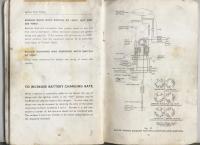...But the question as to WHAT causes an increased load on a motor when you add another electrical component? Does using more electrical power cause more resistance?
...
To try to put things simply, the alternator (which Yamaha insists on calling a magneto) is driven by the engine, so the fuel consumption of the engine does depend on the load that the alternator presents to the engine.
The alternator, if electrically unloaded, would present only inertial loads on the engine plus a marginal mechanical loss in its bearings.
When the alternator is asked to deliver power by the regulator/rectifier, that power comes from the mechanical drive from the engine, plus some inefficiency due to winding resistance and eddy current losses in the metalwork. The efficiency won't vary much over the normal working range, and I guess the alternator would be something like 70% efficient, so if asked to provide 100 watts of electrical energy it would require 100 x 100/70 or about 143 watts of mechanical power, or if asked for 400 watts that would be about 400 x 100/70 or 571 watts.
At low speeds the alternator may not be capable of providing sufficient power, it's not producing enough voltage - the unloaded voltage is directly proportional to the speed.
The maximum current the alternator can ever deliver is limited by the winding inductance, this is a parameter that the original designer would be aware of in the specification. Somewhat counter-intuitively, you can't hurt the alternator by short-circuiting its windings, it limits its own current to this maximum value regardless of speed - inductive reactance is proportional to the inductance and the frequency, so as the speed increases the voltage increases but so does the frequency and hence the reactance, so the current remains the same. For a Gen II this current would be about 42 amps (14V, 590W, the specification is obviously after the regulator).
Equally counter-intuitively, when short-circuited, it is delivering no power (zero voltage at the short circuit, so whatever the current, the delivered power is zero). So, apart from the resistive and eddy-current losses, it's asking little mechanical power from the engine.
Charge a battery and/or supply the bike's electrical load, then the delivered voltage from the alternator is probably 16 or 17 volts (allowing for voltage drop in the regulator), now the power is significant, 16 x 42 x 100/70 = 960 mechanical watts demanded from the engine, or nearly 1.3 HP.
It is the regulator's job to limit the voltage at the battery to its nominal full charge value, a little over 14V. It does this by rapidly connecting the alternator to the battery or disconnecting it (and in the case of the Gen I shorting it to ground
* ).
To sum up, whatever electrical power the alternator gives out is mirrored by the mechanical power from the engine (plus inefficiency losses), and so fuel burned.
Hope that gives some sort of explanation. I realise I've simplified, and left out bits, but that's the gist of it.
* By "ground" I mean the system 0V, battery negative, chassis, not true earth - I've seen some pedantic semantic arguments about this on this very forum
.














